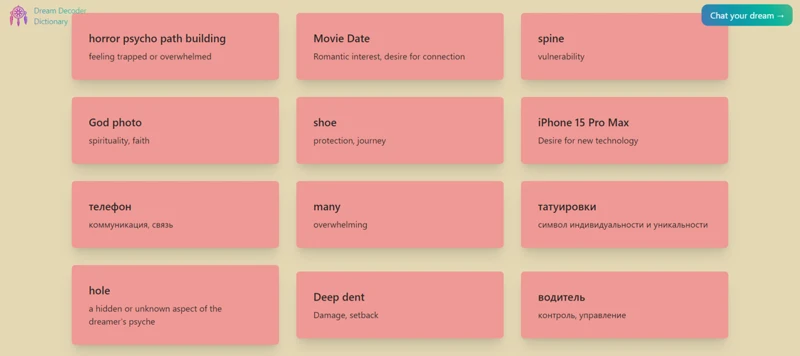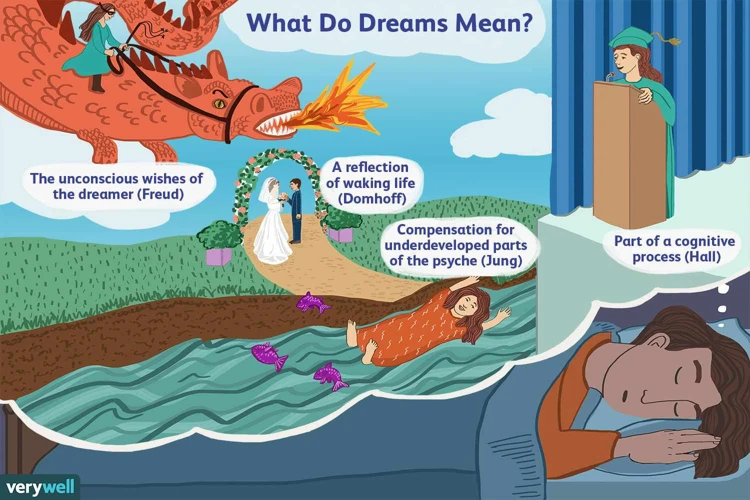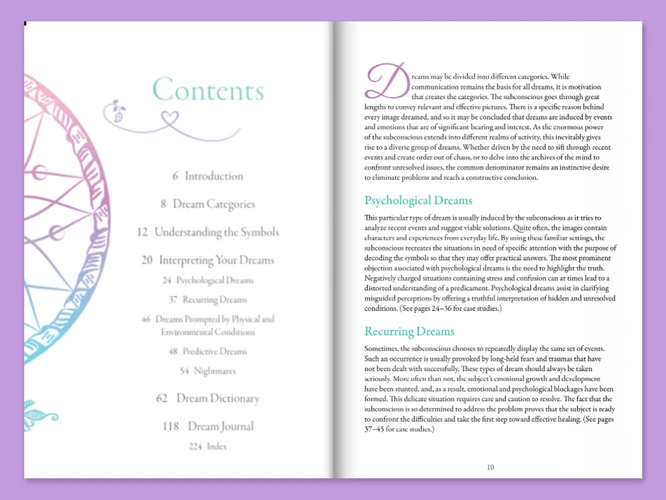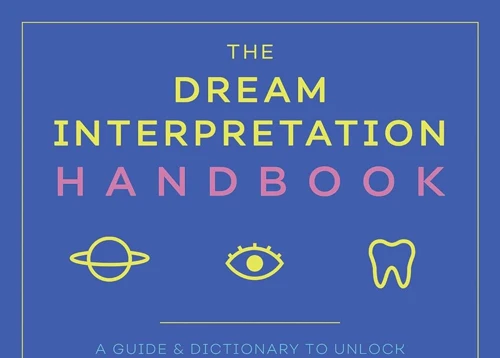Unlock the Mysteries of Your Mind: Learn Dream Interpretation with Our Comprehensive Guide. Have you ever woken up from a dream that left you feeling confused, intrigued, or even slightly disturbed? Dreams hold a vast realm of hidden meanings and messages waiting to be deciphered. But where do you begin in understanding the complex world of dreams? Look no further. Our comprehensive guide to dream interpretation will take you on a fascinating journey to unlock the secrets of your mind. From understanding the science behind dreams to decoding symbol meanings, interpreting emotions, and even exploring the realms of lucid dreaming, this guide provides step-by-step instructions to help you navigate the enigmatic world of dreams. So, get ready to dive deep into the realm of your subconscious and discover the intriguing landscapes that unfold when you close your eyes at night.
Understanding Dreams

Dreams are mysterious and captivating experiences that occur during sleep, with countless individuals seeking to decipher their hidden meanings. To embark on this journey of understanding, it is essential to delve into the science behind dreams and explore the common types they encompass. The science behind dreams examines the brain’s activity during sleep, highlighting the role of REM (rapid eye movement) sleep in the creation of dreams. This stage of sleep is characterized by heightened brain activity, vivid imagery, and intense emotions. Common types of dreams can range from flying dreams, where one soars through the sky with a sense of freedom, to falling dreams, where the sensation of plummeting triggers an adrenaline rush. Another common type is being chased dreams, which often reflect feelings of insecurity or fear in one’s waking life. By unraveling the science and various types of dreams, a deeper understanding of their significance can be attained.
1. The Science Behind Dreams
The science behind dreams is a fascinating field of study that seeks to uncover the mysteries of why and how we dream. During the rapid eye movement (REM) stage of sleep, the brain becomes highly active and generates vivid imagery, emotions, and narratives that we experience as dreams. This stage of sleep is crucial for processing memories, consolidating learning, and regulating emotions. Neuroscientists believe that dreams are the result of the brain’s attempt to make sense of the random firing of neurons during REM sleep. Dreams can range from fantastical scenarios to realistic representations of our daily lives. Understanding the science behind dreams can provide valuable insights into the workings of the brain and our subconscious mind. To learn more about the specific science behind dreams, you can explore our in-depth article on the topic here.
2. Common Types of Dreams
Common Types of Dreams
– Flying Dreams: In these dreams, individuals experience the exhilarating sensation of soaring through the sky. It symbolizes freedom, liberation, and a sense of transcending limitations. Flying dreams can be related to feelings of empowerment and success in one’s waking life. They can also indicate a desire for escape or a need to rise above challenges and obstacles. To learn more about the symbolic meanings of flying dreams, click here.
– Falling Dreams: Falling dreams are characterized by the sensation of plummeting from a great height. These dreams often evoke a sense of fear and vulnerability. Falling dreams can reflect feelings of failure, loss of control, or a fear of letting go in one’s waking life. They may also represent a lack of stability or a sense of insecurity. To explore the deeper meanings of falling dreams, click here.
– Being Chased Dreams: Dreams of being chased typically evoke feelings of anxiety, fear, and a sense of urgency. These dreams may symbolize avoidance, unresolved conflicts, or the need to confront a particular situation in one’s life. Being chased dreams can also indicate a fear of being judged or criticized. To delve into the interpretations of being chased dreams, click here.
Interpreting Dream Symbols

Dream symbols hold a key to unlocking the hidden messages within our dreams. Interpreting dream symbols involves analyzing both personal and universal symbol meanings. Personal symbols are unique to each individual and may derive from personal experiences, memories, or deeply rooted emotions. Keeping a dream journal can be immensely helpful in deciphering these personal symbols and identifying recurring themes. On the other hand, universal symbol meanings are shared by many cultures and societies, representing common archetypes and themes. These symbols can range from animals and objects to weather phenomena and colors. For example, dreaming about a plane crash could symbolize a fear of failure or loss of control, while dreaming about packing and being late may indicate anxiety or feeling overwhelmed. By understanding and analyzing dream symbols, we can gain insights into our subconscious mind and unravel the underlying messages our dreams are trying to convey. (Anchor link: dream meaning plane crash, dreams about packing and being late)
1. Analyzing Personal Symbols
Analyzing Personal Symbols plays a crucial role in understanding the meaning behind your dreams. Each individual has unique personal symbols that hold specific significance to them. By keeping a dream journal and jotting down the symbols that appear in your dreams, you can start to analyze their meaning and relevance in your life. These symbols can include people, objects, animals, or even specific locations. For example, if you frequently dream about a particular person, it could indicate a close relationship or an unresolved issue with them. By paying attention to these personal symbols and exploring their connections to your waking life, you can gain valuable insights into your subconscious thoughts and emotions.
2. Universal Symbol Meanings
Universal symbol meanings play a significant role in dream interpretation. These symbols are shared across cultures and have similar interpretations for most individuals. For example, water often represents emotions and the subconscious mind, while fire symbolizes passion and transformation. Dreams containing animals may indicate specific traits or characteristics associated with those animals, such as a lion representing courage or a snake representing transformation. Common universal symbols also include numbers, such as the number seven symbolizing spirituality and the number three symbolizing creativity. By understanding these universal symbol meanings, dreamers can gain deeper insights into the messages conveyed by their dreams.
Decoding Dream Scenarios

Dream scenarios hold valuable clues that can help us uncover hidden meanings within our dreams. By decoding these scenarios, we gain insight into our subconscious thoughts and emotions. Flying dreams, for example, often signify a desire for freedom, exploration, or transcendence. They can also represent a sense of empowerment or escaping from a challenging situation. Falling dreams, on the other hand, typically symbolize a loss of control or a fear of failure. They might indicate anxiety or insecurity in certain aspects of our lives. Being chased dreams suggest feelings of being pursued or threatened in some way, reflecting our fears or anxieties about unresolved issues. By analyzing and understanding dream scenarios, we can gain valuable insights into our innermost thoughts and emotions, paving the way for personal growth and self-discovery.
1. Flying Dreams
Flying dreams are a fascinating and exhilarating experience that captivates the dreamer. In these dreams, individuals find themselves soaring through the sky, defying gravity, and experiencing a sense of freedom and liberation. Flying dreams symbolize empowerment, exploration, and a newfound sense of control. They often represent a desire for freedom, breaking free from limitations, and reaching new heights in life. These dreams can also indicate a sense of confidence, success, and the ability to overcome obstacles. Additionally, flying dreams may reflect a need for escape or a desire to transcend everyday problems and responsibilities. Embracing the wonder and joy of flying dreams can provide insight into one’s aspirations, ambitions, and inner strength.
2. Falling Dreams
Falling dreams are a common and often unsettling experience for many individuals. When you find yourself plummeting from great heights in your dreams, it can evoke feelings of fear, vulnerability, and a loss of control. While falling dreams can be distressing, they often symbolize a loss of stability or a fear of failure in waking life. The sensation of falling may represent a lack of confidence, a fear of taking risks, or a feeling of being overwhelmed by life’s challenges. These dreams can serve as a gentle nudge to confront your fears, regain control, and embrace change. Exploring the underlying emotions and circumstances associated with falling dreams can provide valuable insights into your subconscious thoughts and help you navigate the uncertainties in your waking life. So, next time you find yourself descending through the abyss in your dreams, remember that it is an opportunity to confront your fears head-on and regain your footing in life.
3. Being Chased Dreams
Being chased dreams are a common theme in the realm of dreams. The feeling of being pursued can evoke a strong sense of fear and anxiety. The interpretation of these dreams can vary depending on the context and individual circumstances. In some cases, being chased in a dream may symbolize running away from a problem or situation that feels overwhelming. It could be an indication of unresolved conflicts or unresolved fears that need to be addressed. Alternatively, being chased dreams could represent a desire for escape or a need to confront and overcome obstacles in one’s life. These dreams may also signify feelings of being overwhelmed or pursued by responsibilities or obligations. Exploring the emotions and the specific details of the dream can provide valuable insight into its meaning and significance.
Unveiling Emotions in Dreams

Emotions play a significant role in shaping our dreams, providing valuable insights into our subconscious thoughts and feelings. Dreams have the power to evoke a wide range of emotions, and understanding these emotional cues can unlock hidden meanings. One common emotion experienced in dreams is fear and anxiety. Nightmares and unsettling dreams often reflect our anxieties, allowing us to confront and process them in a safe space. On the other hand, dreams can also bring forth feelings of happiness and joy, providing a sense of euphoria and fulfillment. These dreams may represent our desires, aspirations, or moments of pure bliss. Dreams can also be a vessel for expressing anger and frustration, serving as a release for pent-up emotions. By delving into the emotions embedded within our dreams, we gain a deeper understanding of ourselves and the underlying emotional landscape that shapes our waking lives.
1. Fear and Anxiety
Fear and anxiety emotions can manifest themselves in various ways within dreams. When experiencing fear in a dream, pay attention to the specific context and symbols surrounding it. Nightmares often evoke intense feelings of fear, usually linked to unresolved fears or real-life stressors. These dreams can serve as a mirror to our anxieties, allowing us to confront and process them in a safe environment. Anxiety dreams are characterized by a sense of unease, restlessness, or worry. They may showcase scenarios or situations that reflect our underlying concerns or insecurities. Analyzing the symbols and scenarios in fear and anxiety dreams can provide valuable insight into our subconscious fears and help us address them in our waking life.
2. Happiness and Joy
Within the realm of dream interpretation, the emotions of happiness and joy hold significant importance. When experiencing dreams filled with happiness and joy, it often reflects a positive state of mind and a deep sense of contentment. These dreams can manifest in various scenarios, such as celebrating special occasions, spending time with loved ones, or achieving personal goals. The emotions evoked during these dreams can have a profound impact on one’s waking life, providing a sense of inspiration, motivation, and overall well-being. The symbols and events within these dreams can offer insights into what brings genuine happiness and fulfillment to an individual’s life. Whether it’s a dream of laughter, success, or pure bliss, the presence of happiness and joy in dreams can serve as a reminder to prioritize happiness and seek out experiences that bring genuine joy. Understanding and embracing these positive emotions within dreams can contribute to a more fulfilling and joyful waking life.
3. Anger and Frustration
Anger and frustration are common emotions that can manifest in dreams, providing valuable insights into one’s waking life. When experiencing anger or frustration in a dream, it is crucial to examine the underlying cause of these emotions. Dreams can serve as a way for the subconscious mind to process and release pent-up anger or frustration that may be present in one’s daily life. This could be a result of unresolved conflicts or situations that are causing stress. Pay attention to the specific details and scenarios in the dream as they may offer clues about the source of these emotions. By recognizing and addressing these feelings, one can gain a deeper understanding of their personal struggles and work towards finding resolutions for a more peaceful and fulfilling life.
Lucid Dreaming and Control

Lucid dreaming is a captivating phenomenon that allows individuals to become aware that they are dreaming while the dream is still in progress. This realization opens up a world of possibilities, as dreamers gain the ability to control and manipulate the dream environment. Understanding the fundamentals of lucid dreaming is the first step towards experiencing this unique state of consciousness. Lucid dreaming occurs when the dreamer becomes conscious of their dream while it is happening, enabling them to participate actively and make deliberate choices within the dream world. Techniques such as reality checks, mnemonic induction, and keeping a dream journal can help increase the likelihood of having lucid dreams. Once in a lucid dream, individuals can engage in extraordinary experiences, such as flying through the skies, teleporting to different locations, or even transcending the boundaries of reality. These techniques and practices provide a pathway to unlocking the extraordinary potential of the dreaming mind.
1. Introduction to Lucid Dreaming
Lucid dreaming is a fascinating phenomenon that occurs when one becomes aware that they are dreaming while still in the dream state. This heightened state of consciousness provides an opportunity to actively participate in and even manipulate the dream world. Lucid dreaming can be an exhilarating and empowering experience, allowing individuals to explore their imagination, overcome fears, and even practice new skills within the confines of their dreams. Techniques such as reality checks, dream journaling, and visualization exercises can be employed to increase the likelihood of having lucid dreams. Once an individual has mastered the art of lucid dreaming, the possibilities for self-discovery and personal growth become limitless. So dive into the realm of lucid dreaming and unlock a world where you can seize control and shape your dreamscape into anything your heart desires.
2. Techniques to Enhance Lucid Dreams
– Reality Checks: Perform reality checks throughout the day to cultivate awareness and increase the chances of having lucid dreams. Simple techniques include looking at a digital clock twice, as the numbers may change in dreams, or attempting to push a finger through the palm of your hand.
– Dream Journaling: Keep a dream journal by your bedside and make a habit of recording your dreams immediately upon waking. This practice improves dream recall and helps identify patterns and dream signs, making it easier to recognize when you’re dreaming.
– MILD Technique: Mnemonic Induction of Lucid Dreams (MILD) involves setting an intention before sleep by repeating affirmations such as “I will have a lucid dream tonight.” Visualize yourself becoming aware and taking control of the dream.
– Reality Testing While Dreaming: Once you achieve some level of lucidity in a dream, perform reality tests to increase stability and control. This may include looking at your hands, observing objects, or interacting with dream characters while maintaining awareness of the dream state.
– Wake-Back-to-Bed (WBTB): Set an alarm for several hours before your usual wake-up time. When the alarm goes off, stay awake for a short period, engage in activities related to lucid dreaming (reading about it, meditating, etc.), and then go back to sleep. This technique enhances the likelihood of entering the REM stage directly, where lucid dreams are more likely to occur.
Keeping a Dream Journal

Keeping a dream journal is a powerful tool in unlocking the mysteries of your mind. By recording your dreams upon waking, you can capture the intricate details, emotions, and symbols that may fade from memory throughout the day. A dream journal acts as a repository for your subconscious experiences, providing a valuable resource for interpretation and analysis. Writing in your dream journal should be a daily practice, preferably immediately upon waking to capture the freshest memories. Include as much detail as possible, describing the setting, characters, actions, and any significant emotions. Additionally, document any recurring themes or symbols that appear in your dreams over time. Reflecting on your dream journal over a period can reveal patterns, personal associations, and even potential solutions to real-life challenges. Remember, the more you engage with your dreams through journaling, the deeper your understanding will become. So, grab a notebook or create a digital journal, and embark on a fascinating journey of self-discovery through your dreams.
Common Dream Themes

Dreams often encompass recurring themes that are shared among individuals, offering insights into our subconscious minds. Three common dream themes include falling, teeth falling out, and being naked in public. Falling dreams can evoke a sense of vulnerability and loss of control, representing insecurities or a fear of failure. On the other hand, dreams about teeth falling out can be associated with feelings of powerlessness or a concern about one’s appearance or communication skills. Being naked in public dreams can induce feelings of embarrassment and vulnerability, symbolizing a fear of judgment or feeling exposed in certain aspects of life. These thematic elements provide a starting point for unraveling the deeper meanings behind our dreams, prompting self-reflection and exploration. To learn more about dream interpretation and the significance of these common themes, delve into our comprehensive guide.
1. Falling
Falling dreams are a common dream theme that can evoke a range of emotions and interpretations. When you dream about falling, it often symbolizes a loss of control or a fear of failure in your waking life. This type of dream may reflect a sense of insecurity, instability, or a lack of support in your current circumstances. It can also represent a feeling of being overwhelmed or overwhelmed by a challenging situation. While falling dreams can be unsettling, they can also serve as a reminder to face your fears and regain a sense of control. Remember, the interpretation of falling dreams can vary based on personal experiences and emotions, so it’s important to reflect on your own feelings and circumstances when analyzing this dream symbol.
2. Teeth Falling Out
Teeth falling out dreams, a common and perplexing experience, often leave individuals feeling a sense of unease upon waking. These dreams involve the sudden loss or crumbling of teeth, which can evoke feelings of vulnerability, insecurity, or powerlessness. While the exact interpretation may vary depending on personal experiences and beliefs, there are some common explanations for this dream symbol. In some instances, teeth falling out dreams can signify concerns related to one’s appearance or self-image. They may also reflect anxieties about communication, the fear of being misunderstood, or the inability to express oneself effectively. Additionally, these dreams can be associated with issues of control, suggesting a lack of control in certain aspects of life or difficulty handling challenging situations. Exploring the meaning behind teeth falling out dreams can offer valuable insights into one’s emotional state and highlight areas of concern that may require attention and resolution.
3. Being Naked in Public
Being Naked in Public is a recurring dream theme that can evoke a range of emotions and feelings of vulnerability. This dream often signifies a fear of being exposed or judged by others. It
Subscribe to Our Newsletter
Sign up to receive the latest news and updates.
Interpreting Nightmares

Nightmares can be a distressing and puzzling experience, leaving individuals feeling shaken and anxious upon waking. Understanding the roots of nightmares is crucial in unraveling their hidden meanings. Nightmares often stem from unresolved fears, traumas, or stressful situations in one’s life. By exploring these underlying factors, individuals can gain insight into their subconscious fears and work towards resolving them. Coping strategies play a vital role in managing nightmares, such as practicing relaxation techniques, creating a soothing bedtime routine, or even seeking professional help if necessary. It is important to recognize that nightmares can serve as valuable messages from the subconscious, offering an opportunity for personal growth and self-reflection. By delving into the depths of nightmares and employing effective coping strategies, individuals can gain control over their dreams and transform them into sources of empowerment and self-discovery.
1. Understanding the Roots of Nightmares
Understanding the roots of nightmares is essential in unraveling their meanings and significance. Nightmares are intense and distressing dreams that often leave individuals feeling frightened and unsettled upon waking up. These dreams can be triggered by a variety of factors, including past traumas, unresolved emotions, anxiety, or even certain medications. Exploring the underlying causes of nightmares can provide valuable insights into one’s fears, anxieties, and unresolved issues. By identifying the root causes, individuals can take steps towards addressing and coping with these fears, ultimately promoting better sleep and emotional well-being. Remember, nightmares can offer valuable messages from the subconscious, and understanding their roots is the key to unlocking their hidden meanings.
2. Coping Strategies
– Develop a relaxation routine before bedtime, such as deep breathing exercises or meditation, to promote a sense of calmness and reduce stress levels.
– Seek support from a therapist or counselor who specializes in dream interpretation and can help you navigate and process the emotions associated with nightmares.
– Practice stress management techniques, such as exercise, journaling, or engaging in hobbies, to alleviate anxiety and promote a sense of well-being.
– Establish a soothing sleep environment by creating a comfortable and peaceful bedroom setting, with dim lighting, soft colors, and relaxing aromas.
– Engage in positive and uplifting activities before bed, such as reading a book, listening to calming music, or practicing gratitude, to shift your mind towards more pleasant thoughts and emotions.
– Consider dream journaling and reflection as a way to uncover any underlying emotional or psychological issues that may be contributing to recurring nightmares, and work towards their resolution.
Prophetic Dreams and Premonitions

Dreams have long intrigued humanity with their potential to offer glimpses into future events. Prophetic dreams and premonitions are one such fascinating aspect of dream interpretation. These dreams are characterized by their ability to foresee future occurrences, often with astonishing accuracy. Recognizing prophetic dreams can be perplexing, as they are often veiled in symbolism and metaphor. However, certain signs may indicate their prophetic nature, such as vividness, strong emotions, and a heightened sense of realism. Understanding and interpreting prophetic dreams involves honing one’s intuition and developing a deeper connection to the subconscious mind. By empowering your intuition and paying close attention to the messages conveyed in these extraordinary dreams, you can tap into a wellspring of foresight and unlock the ability to navigate life’s twists and turns with greater insight. So, embrace the mysterious world of prophetic dreams, for they may hold the keys to preparing for future events and shaping your destiny.
1. Recognizing Prophetic Dreams
Recognizing Prophetic Dreams. Prophetic dreams are dreams that seem to predict future events or provide insights into future circumstances or situations. These dreams can be vivid and intense, leaving a lasting impression in the dreamer’s mind. To recognize prophetic dreams, one must pay attention to the details and symbolism within the dream. Often, these dreams carry a strong sense of déjà vu or a gut feeling that the dream is significant. It is important to keep a dream journal and document these dreams, as they may become valuable references in the future when events align with the dream’s content. Developing intuition and being open to the possibility of prophetic dreams can further enhance the ability to recognize these unique and captivating dream experiences.
2. Empowering Your Intuition
Empowering Your Intuition. When it comes to interpreting dreams, intuition plays a vital role in uncovering their deeper meanings. Developing and trusting your intuition can enhance your ability to understand the messages hidden within your dreams. Intuition is the innate inner knowing or gut feeling that guides us without logical reasoning. To empower your intuition, it is important to practice mindfulness and connect with your inner self. Meditating, journaling, and reflecting on your dreams can help strengthen your intuitive abilities. Pay close attention to any intuitive insights or hunches that arise during dream interpretation, as they may provide valuable clues to understanding the symbolism and messages conveyed in your dreams. Embracing and trusting your intuition allows you to tap into a deeper level of understanding and gain profound insights from your dream experiences.
Interpreting Recurring Dreams

Recurring dreams are both intriguing and perplexing, appearing repeatedly in one’s sleep and leaving a trail of unanswered questions. To unlock the hidden messages within these dreams, it is crucial to identify any patterns that emerge. By keeping a dream journal and recording the details of recurring dreams, common themes, symbols, or emotions can be identified, shedding light on their deeper meaning. These dreams often stem from unresolved issues or unresolved emotions, and by exploring their recurring nature, individuals can gain insight into their own lives and experiences. Whether it’s a recurring dream about falling, teeth falling out, or being naked in public, each dream holds a unique significance and can offer valuable insights into the subconscious mind. By interpreting recurring dreams, individuals have the opportunity to address unresolved issues and achieve personal growth and self-discovery.
1. Identifying Patterns
Identifying patterns in recurring dreams is a crucial step in unraveling their meaning. Patterns can be found in various elements such as symbols, themes, emotions, or even specific scenarios that repeat across different dream experiences. By keeping a dream journal and noting down details of each dream, you can start noticing similarities and connections between different dreams. Look for common symbols or themes that occur frequently, as well as any recurring emotions or unresolved issues that seem to manifest in your dreams. Once you identify these patterns, you can begin to decipher their significance and gain a deeper insight into your subconscious mind.
2. Resolving Unresolved Issues
Resolving unresolved issues in recurring dreams is a crucial aspect of dream interpretation. When certain themes or scenarios appear repeatedly in our dreams, it often indicates that there are unresolved emotions or conflicts in our waking lives. By analyzing these recurring dreams and identifying the patterns or symbols within them, we can gain insight into the underlying issues that need to be addressed. This process allows us to confront and resolve these unresolved issues, leading to personal growth and emotional healing. It is through the exploration and interpretation of recurring dreams that we can begin to unravel the complexities of our subconscious and find resolution to the unresolved.
Dreams and the Subconscious Mind

Dreams hold a profound connection to the subconscious mind, acting as a gateway to its deepest realms. The subconscious mind is an influential force that operates beneath the surface of our conscious awareness, shaping our thoughts, emotions, and behaviors. It is within the realm of dreams that the subconscious mind manifests its hidden desires, fears, and unresolved conflicts. The role of the subconscious in dreams is to provide a symbolic representation of our innermost thoughts and feelings, often unveiling aspects of ourselves that we may not be consciously aware of. By analyzing and interpreting the content of our dreams, we gain valuable insights into our subconscious processes, allowing us to unlock the secrets of our own psyche and embark on a path of self-discovery. Whether it’s deciphring recurring patterns, resolving unresolved issues, or tapping into our intuitive abilities, exploring the connection between dreams and the subconscious mind holds the potential for profound personal growth and understanding.
1. The Role of the Subconscious
The Role of the Subconscious in dream interpretation is crucial to understanding the deeper meanings behind our dreams. The subconscious mind is the part of our consciousness that operates beneath our awareness. It stores memories, emotions, desires, and beliefs that may influence our dreams. It acts as a reservoir of experiences, often manifesting symbolically in our dreams to communicate messages and insights. By exploring the role of the subconscious, we can gain valuable insights into our true selves and uncover hidden aspects of our personalities and emotions. Dreams provide a window into this subconscious realm, allowing us to tap into our innermost thoughts and desires. By analyzing and interpreting the symbols and scenarios presented in our dreams, we can gain a deeper understanding of our subconscious mind and unlock the mysteries it holds.
2. Unlocking Self-Discovery
Unlocking self-discovery is a profound aspect of dream interpretation. Exploring dreams can provide invaluable insights into our subconscious desires, fears, and unresolved issues. By analyzing recurring symbols, emotions, and scenarios in our dreams, we can gain a deeper understanding of ourselves and our personal journeys. Dreams act as a gateway to the subconscious mind, allowing us to tap into our innermost thoughts and feelings. Embracing the process of unraveling our dreams can lead to self-empowerment, personal growth, and a deeper connection with our true selves. It is through this exploration that we can truly unlock the mysteries of our mind and embark on a transformational journey of self-discovery.
Interpreting Color and Emotion in Dreams
Colors play a significant role in our dreams, often representing different emotions and symbolic meanings. When interpreting color and emotion in dreams, it is crucial to analyze the emotional associations tied to specific colors. For example, red may symbolize passion, anger, or intense emotions, while blue can represent calmness, tranquility, or sadness. Yellow is often associated with happiness, optimism, or intellectual stimulation. By paying attention to the prominent colors in your dream, you can gain insights into the emotional landscape of your subconscious mind. Analyzing color symbolism in dreams can provide additional layers of interpretation. For instance, a dream featuring a red car may not only signify intense emotions but also denote a sense of power or aggression tied to the symbol of the car. Exploring the connection between color and emotion within dreams opens up a palette of possibilities to unravel the deeper meanings hidden within the realm of dreams.
1. Emotional Color Associations
When it comes to understanding the emotional color associations in dreams, different colors can evoke a range of feelings and emotions. Here are some common emotional color associations that may appear in your dreams:
- Red: Passion, anger, intensity
- Blue: Calmness, tranquility, sadness
- Yellow: Happiness, joy, energy
- Green: Growth, renewal, envy
- Black: Mystery, fear, the unknown
- White: Purity, innocence, clarity
- Purple: Royalty, spirituality, creativity
- Orange: Warmth, enthusiasm, excitement
These associations can provide insight into the emotions and themes present in your dreams. By paying attention to the colors that appear and the feelings they evoke, you can gain a deeper understanding of the messages and symbolism within your dream experience.
2. Analyzing Color Symbolism
Analyzing Color Symbolism:
– Red: Often associated with passion, energy, and strong emotions, the color red can indicate intense feelings of love, anger, or excitement. It can also symbolize power, courage, or even danger in certain contexts.
– Blue: Symbolizing tranquility, peace, and serenity, blue is often linked to feelings of calmness and relaxation. It can represent trust, loyalty, and stability as well.
– Yellow: This vibrant color is associated with happiness, optimism, and creativity. It can represent joyful experiences, intellectual pursuits, and a sunny outlook on life.
– Green: Symbolizing nature, growth, and harmony, green often represents balance, renewal, and abundance. It can also symbolize jealousy or envy in certain situations.
– Purple: Often associated with royalty, luxury, and spirituality, purple symbolizes elegance, creativity, and mysticism. It can indicate a connection to intuition and higher consciousness.
– Pink: Symbolizing love, compassion, and femininity, pink is often linked to nurturing and affectionate qualities. It can represent innocence, softness, and gentleness.
– Black: While black can have negative connotations, it can also signify power, mystery, and elegance. It can represent the unknown, hidden aspects of the self, or a need for introspection.
– White: Often associated with purity, innocence, and cleanliness, white can also represent new beginnings, clarity, and spiritual awakening. It signifies a blank canvas or a fresh start.
– Orange: Symbolizing energy, enthusiasm, and creativity, orange is often linked to feelings of vitality and excitement. It represents warmth, enthusiasm, and a zest for life.
Understanding the symbolism behind colors in dreams can provide insights into the emotions, themes, and messages embedded within the dream experience. By analyzing the colors present in your dreams, you can gain a deeper understanding of their significance and unlock the hidden messages within your subconscious mind.
Conclusion
In conclusion, delving into the world of dream interpretation allows us to unlock the mysteries hidden within our minds. Through understanding the science behind dreams, analyzing dream symbols, decoding scenarios, and exploring the depths of our emotions, we can gain profound insights into our subconscious selves. Lucid dreaming and keeping a dream journal provide us with tools for enhanced dream experiences and self-discovery. By unraveling recurring dreams, nightmares, and prophetic dreams, we can uncover unresolved issues and tap into our intuition. The importance of dreams in revealing the workings of our subconscious mind cannot be overstated, as they offer valuable guidance and personal growth opportunities. So, embrace the enigma of dreams and embark on a journey of self-exploration, self-reflection, and self-discovery through the art of dream interpretation.
Frequently Asked Questions
1. How often do people dream?
On average, people dream approximately four to six times per night during the REM stage of sleep. However, many of these dreams are quickly forgotten upon waking.
2. Can dreams be influenced by external factors?
Yes, external factors such as stress, medications, and even certain foods can influence the content and intensity of dreams. For example, consuming spicy foods or alcohol before bed may result in more vivid or unusual dreams.
3. Are dreams always in color?
No, dreams can occur in both color and black and white. While some individuals may experience vivid, colorful dreams, others may only recall dreams in grayscale or with minimal color.
4. Can dreams predict the future?
While there are anecdotal accounts of dreams seemingly predicting future events, there is no scientific evidence to support the claim that dreams can accurately predict future occurrences.
5. Why do dreams sometimes feel so real?
Dreams can feel incredibly realistic due to the brain’s ability to create detailed sensory experiences during sleep. The brain activates similar regions that are active when we are awake, leading to a perception of realism within dreams.
6. Can recurring dreams have different interpretations each time?
Yes, recurring dreams can have different interpretations based on the individual’s current life circumstances and emotions. It is essential to analyze the context and personal associations surrounding the recurring dream to gain a deeper understanding.
7. How can I improve dream recall?
Keeping a dream journal next to your bed and writing down any details or emotions immediately upon waking can help improve dream recall. Regularly practicing this technique can train your brain to remember dreams more effectively.
8. Is it possible to control the outcome of a dream?
Yes, through the practice of lucid dreaming, individuals can gain the ability to become aware within a dream and influence its direction. Techniques such as reality checks and maintaining a dream journal can help develop the skill of lucid dreaming.
9. Can dreams help with problem-solving?
Yes, dreams have the potential to offer new perspectives and solutions to problems. By focusing on a problem before sleep, you may invite your subconscious mind to work on it throughout the night, potentially leading to insights in your dreams.
10. Are nightmares always a cause for concern?
Not necessarily. Nightmares can often reflect underlying fears, anxieties, or stresses. By addressing and resolving these underlying issues, nightmares can gradually subside. However, if nightmares persist and significantly impact daily life, it might be helpful to seek professional assistance.










